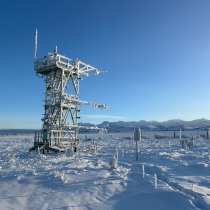Prototyping Continued: Bridging the Gap From Land to Sky
September 16, 2010
Prototyping events during the last three weeks have been integral to establishing a clear and consistent link between NEON organismal and airborne measurements, and are a critical step toward enabling future NEON users to obtain the most complete information possible about a NEON site from the ground to the sky. From mid-August through the first week of September, staff from NEON’s Airborne Observation Platform (AOP) and Fundamental Sentinel Unit (FSU) science teams headed to Florida to prototype planned methods for collecting and scaling data from the organismal level to satellite-based remote sensing level. During that time, AOP successfully conducted a series of pathfinder flights in conjunction with ground-based data collection carried out by FSU scientists. The relationship between data collected by the AOP team and the FSU team is particularly important; because the observatory will operate at the continental scale, the teams must ensure that AOP data can be validated and be interpreted similarly to FSU ground-based data collected in the same areas. Because AOP data will be collected at regional scales versus at a plot level by FSU, it will be possible for NEON to scale to the continental level by using AOP data in complement to FSU data.
During their visit to Florida, FSU staff and seasonal hires collected canopy structure, leaf area index and plant biodiversity measurements at the Ordway-Swisher Biological Station and a University of Florida pine plantation. The following week, the AOP team deployed the Jet Propulsion Laboratory’s (JPL) Airborne Visible/Infrared Airborne Spectrometer (AVIRIS) in a Twin Otter plane in partnership with NASA, as well as the National Center for Airborne Laser Mapping (NCALM) LiDAR system installed in a Piper Chieftan aircraft for a series of flights covering areas around and including the Ordway-Swisher Biological Station. They also conducted ground-based measurements such as vegetation characterization, sun and weather studies, and ground-based measurements of how plant canopies reflect light in order to calibrate and assess the quality of the airborne measurements. Additionally, the AOP team coordinated their measurements with Landsat, EO-1 and MODIS Terra satellite overpasses. This will allow NEON teams to investigate how scaling NEON’s data from the organismal to continental scale might work using the well-known satellite data as validation. The coincident satellite overpasses will also help the AOP team verify their field calibration methods by giving them the ability to compare their ground calibration results to a well-known, well-calibrated sensor.
Both the AOP and FSU teams collected datasets that will help them learn the best strategies for making measurements when NEON moves into the Operations phase. In addition, the teams learned valuable lessons from the experience that will guide future decisions and ensure future data collection goes smoothly. For example, the AOP team will use the experience to inform whether morning spectrometer data collection versus noon collection would work to avoid afternoon convective storms in susceptible regions. The FSU team was able to evaluate what types of equipment and methods work best for measuring vegetation, experiment with how adjustments to sample plot size and shape affect the quality of the data NEON will collect, and streamline the process for how NEON will hire seasonal field crews. Thanks to detailed plans developed by NEON scientists and local support by John Hayes, Steve Coates, Rosvel Bracho-Garillo and others on the UF team, prototyping activities went smoothly and were highly productive. NEON is also grateful for the time and support of NASA’s Terrestrial Ecology Research Program, the JPL AVIRIS team, and NCALM.

